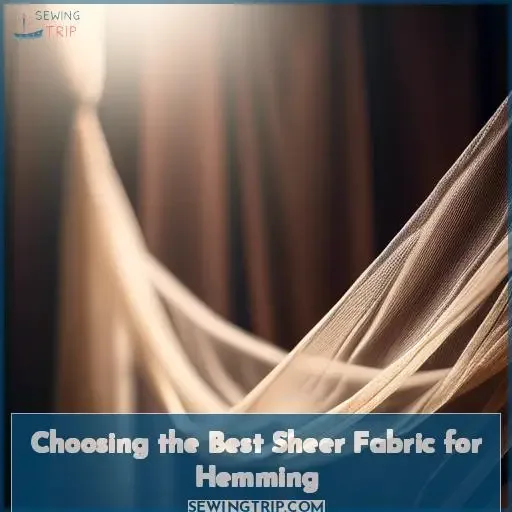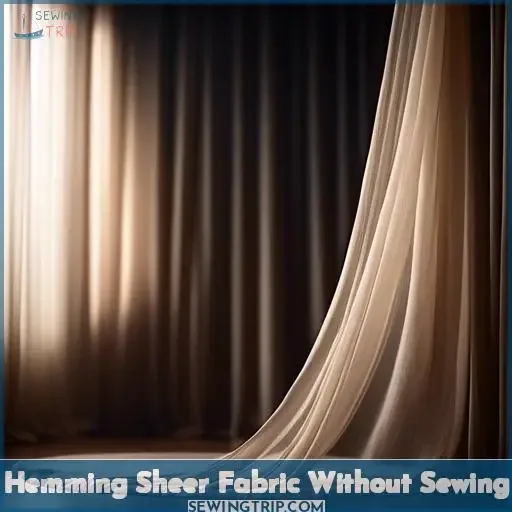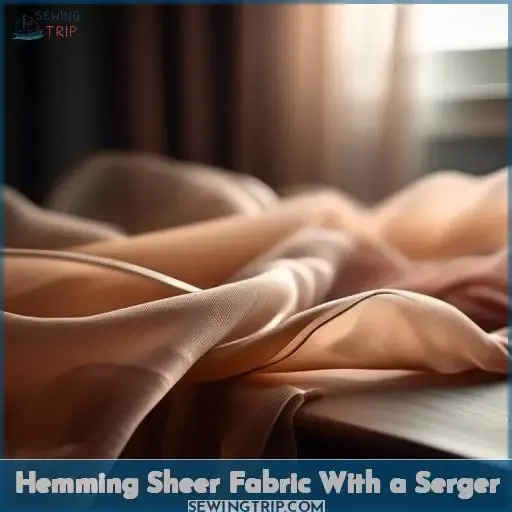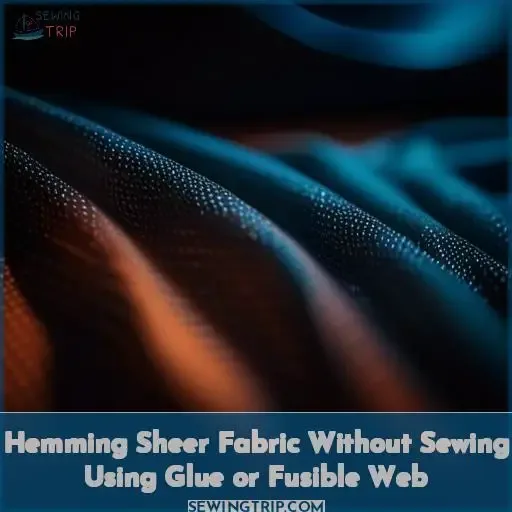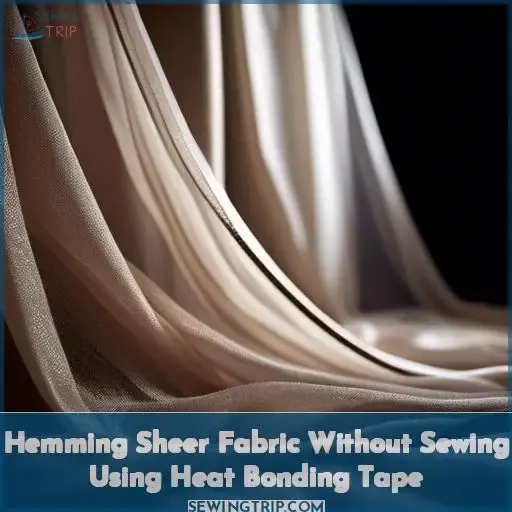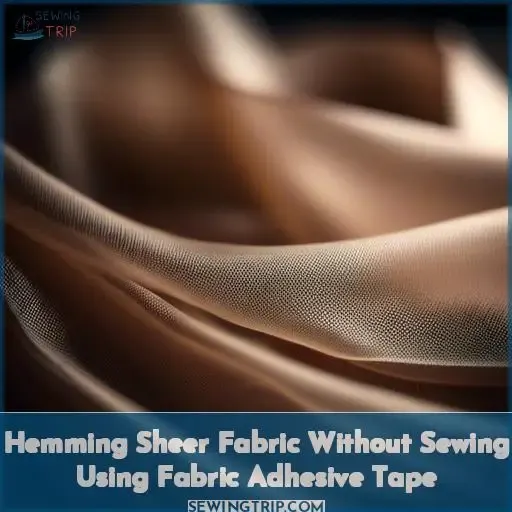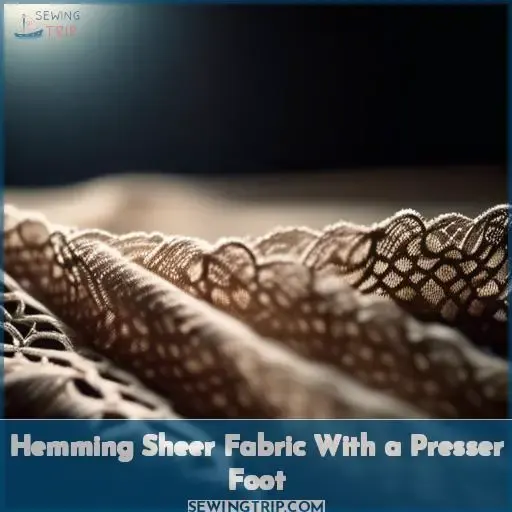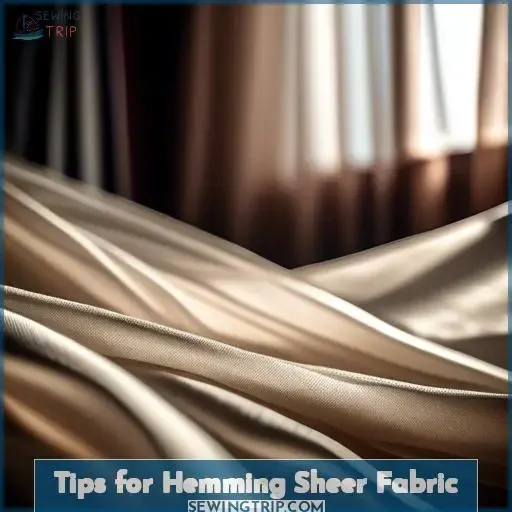This site is supported by our readers. We may earn a commission, at no cost to you, if you purchase through links.
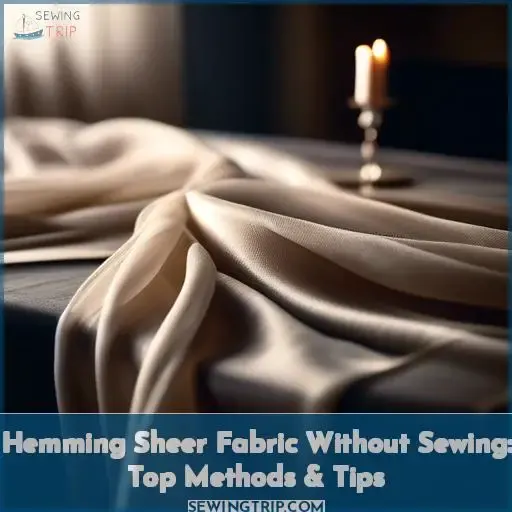
Glue or Fusible Web: This method involves using a fusible adhesive that doesn’t bleed through or stain the fabric. To hem using this method, you need to measure and mark the hemline, apply the glue or fusible web, fold the fabric, and press it to allow the adhesive to dry.
Heat Bonding Tape: Heat bonding tape is a thicker option compared to regular hem tape. It comes in a precut width and can be found in various widths from ¼” to 2” and beyond. When using heat bonding tape, you need to cut it to the desired width, place it along the hemline, and allow the fabric to cool.
Fabric Adhesive Tape: Fabric adhesive tape is another alternative for hemming sheer fabric without sewing. You need to cut the tape to the appropriate width, position it along the hemline, and allow the adhesive to set.
Serger: If you prefer using a serger, you can use a 1/4-inch hemmer, slow hand sewing, or a metal hemmer to hem your sheer fabric.
Alternative Hemming Methods: There are other techniques like rolled hem setting on a serger, fishline hems, and the banroll method that can be used to hem sheer fabric without sewing.
When choosing the best method for your specific project, consider factors such as the fiber content, weight and drape, transparency, stretch and stability, sewing difficulty, and color and pattern of your fabric.
Always test your chosen method on a scrap piece of your fabric before proceeding to ensure the adhesive doesn’t bleed through or stain the fabric.
Table Of Contents
- Key Takeaways
- How to Hem Sheer Fabric Without Sewing
- Top 3 Best Sheer Fabrics for Hemming
- Choosing the Best Sheer Fabric for Hemming
- Hemming Sheer Fabric Without Sewing
- Hemming Sheer Fabric With a Serger
- Alternative Hemming Methods
- Hemming Sheer Fabric Without Sewing Using Glue or Fusible Web
- Hemming Sheer Fabric Without Sewing Using Heat Bonding Tape
- Hemming Sheer Fabric Without Sewing Using Fabric Adhesive Tape
- Hemming Sheer Fabric With a Presser Foot
- Tips for Hemming Sheer Fabric
- Frequently Asked Questions (FAQs)
- Conclusion
Key Takeaways
Utilizing fusible webbing or fabric adhesive tape offers a quick and easy solution for hemming sheer fabric without the need for sewing, making it accessible for those without sewing skills or equipment.
Heat bonding tape provides a durable option for no-sew hemming, allowing for a clean and professional finish that can withstand washing and ironing, as long as the appropriate heat settings are used for the fabric type.
For those seeking a no-sew method, it’s important to consider the fabric’s characteristics such as weight, drape, and transparency to ensure the chosen hemming technique complements the fabric’s properties and achieves the desired outcome.
Testing the chosen no-sew hemming method on a scrap piece of the sheer fabric before proceeding with the actual project is recommended to ensure compatibility and prevent damage to the fabric.
How to Hem Sheer Fabric Without Sewing
To hem sheer fabric without sewing, you can use fabric glue, fusible web, or hemming tape activated by heat.
Top 3 Best Sheer Fabrics for Hemming
When it comes to hemming sheer fabrics, there are several options available that don’t require sewing.
Plantional Fusible Bonding Web: This is a type of adhesive that can be used to bond the fabric to itself, creating a hem without the need for sewing. It’s ideal for lightweight and sheer fabrics, as it provides a strong bond while remaining flexible and invisible.
HeatnBond UltraHold IronOn Adhesive: This is another type of adhesive that can be used to create a hem without sewing. It’s designed to be heat-activated, so you can use an iron to melt the adhesive and bond the fabric to itself. It’s suitable for a wide range of fabrics, including sheer and lightweight materials.
TSSART Fabric Tape Adhesive Cloth: This is a fabric tape that can be used to create a hem without sewing. It’s designed to be easy to apply and remove, and it provides a strong bond that can hold up to wear and tear. It’s suitable for a wide range of fabrics, including sheer and lightweight materials.
When choosing the best sheer fabric for hemming, there are several factors to consider:
- Fiber Content: The type of fiber in the fabric can affect its properties, such as its drape and stability.
- Weight and Drape: The weight and drape of the fabric can influence how it behaves when being hemmed.
- Transparency: The level of transparency of the fabric can affect how visible the hem is.
- Stretch and Stability: The amount of stretch and stability in the fabric can affect how easy it’s to work with and how well it holds its shape.
- Sewing Difficulty: The ease of sewing with the fabric can influence how much time and effort are required to hem it.
- Color and Pattern: The color and pattern of the fabric can affect how visible the hem is.
When hemming sheer fabric without sewing, there are several methods you can use:
- Glue or Fusible Web: You can apply glue or fusible web along the hemline and then fold the fabric and press it to create a hem.
- Heat Bonding Tape: You can use heat bonding tape along the hemline and then press the fabric to create a hem.
- Fabric Adhesive Tape: You can use fabric adhesive tape along the hemline and then fold the fabric and press it to create a hem.
If you prefer to use a sewing machine, you can also use a serger to create a rolled hem. A serger with a 1/4 inch hemmer can be used to create a narrow, tidy hem that’s ideal for lightweight fabrics. Alternatively, you can use a metal hemmer with curls specifically made for the fabric to create a decorative hem.
1. Plantional Fusible Bonding Web
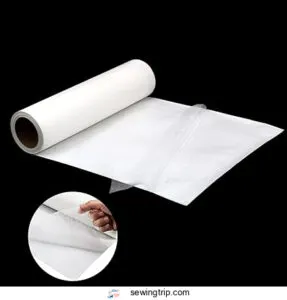
Hemming sheer fabric without sewing can be a daunting task, but there are several methods and tips to make it easier. One of the top methods is using a fusible bonding web, such as the Plantional Fusible Bonding Web.
This web allows you to turn any fabric into a fusible fabric without stiffening it, and it bonds firmly once cooled.
Preparation: Start by measuring and marking the hemline on your sheer fabric. Then, apply the fusible web along the hemline, ensuring it covers the entire area.
Folding and Pressing: Fold the fabric along the hemline, pressing it with a hot iron to set the adhesive. Be careful not to burn the fabric, as it may be delicate.
Drying and Finishing: Allow the adhesive to dry completely before moving on to the next step. Once dry, you can fold the fabric again to enclose the stitched-down raw edge and stitch close to the inside fold.
- No sewing required
- Suitable for various fabric types
- Can be used for hemming broken or torn fabrics
- Doesn’t stiffen the fabric
- Bonds firmly once cooled
- May require additional tools, such as an iron and a ruler
- Can be time-consuming compared to sewing
- May not be as durable as a sewn hem
2. HeatnBond UltraHold IronOn Adhesive
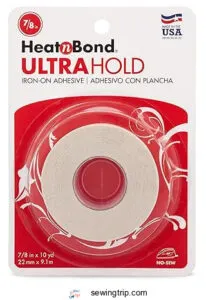
In the realm of hem-free sewing, HeatnBond UltraHold IronOn Adhesive stands out as a top choice for bonding fabric without the need for pinning. With its strong adhesion, it’s suitable for a variety of projects, including fabric hems.
- Strong Adhesion: HeatnBond UltraHold provides a reliable and strong bond, making it suitable for a variety of projects, including fabric hems.
- No Sewing Needed: The adhesive eliminates the need for sewing, which can be a time-saving advantage for those who prefer a no-sew approach.
- Permanent Bond: Once applied, the bond is permanent, ensuring that the hem stays in place.
- Not Reusable: Once applied, the bond is permanent, so any mistakes can’t be easily corrected without damaging the fabric.
- Thicker Bond: The adhesive can be thicker than traditional fusible webs, which may require more pressure when ironing.
If you’re considering using HeatnBond UltraHold IronOn Adhesive for hemming, it’s important to keep in mind that it’s designed for bonding fabric without the need for pinning. To use it, you’ll need to pre-wash all materials without fabric softeners, pretreat the adhesive on materials before starting the project, and preheat your iron to medium heat, no steam.
Once you’ve applied the adhesive to the wrong side of the material, you’ll need to place the iron on the paper liner for 2 seconds and repeat until the entire surface is bonded. Allow the adhesive to cool before cutting it to size or shape. Remember, it’s not designed for sewing, so if stitching is required, use HeatnBond Lite instead.
3. TSSART Fabric Tape Adhesive Cloth
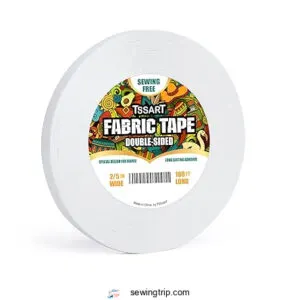
When it comes to hemming sheer fabrics, there are several options available, one of which is using TSSART Fabric Tape Adhesive Cloth. This double-sided tape is designed for fabric and offers a strong adhesive that can handle heavy fabric bonding.
- Strong adhesive for heavy fabric bonding
- No sewing or ironing required
- Can be used for various applications, including hemming
- Machine washable and dryable, making it suitable for wearables
- May not stick to all textures
- Can gum up sewing machine needles if sewn through
- Hard to remove backing
TSSART Fabric Tape Adhesive Cloth is a versatile option for hemming sheer fabrics, as it provides a strong bond without the need for sewing or ironing. However, it may not adhere well to all textures, and it can be challenging to remove the backing.
Additionally, it can gum up sewing machine needles if sewn through, which is something to consider when using this tape.
Choosing the Best Sheer Fabric for Hemming
When choosing the best sheer fabric for hemming, consider the following factors:
Fiber Content: Look for fabrics made from materials like silk, cotton, or synthetics, as these are commonly used for sheer fabrics.
Weight and Drape: Lightweight fabrics like chiffon, organza, and voile are suitable for hemming, as they drape well and are less transparent than other sheer fabrics.
Transparency: Consider the level of transparency you want for your hem. Some fabrics like organza are more see-through than others, like voile.
Stretch and Stability: If your fabric has stretch, ensure it’s stable enough for hemming. Stretchy fabrics may require different techniques.
Sewing Difficulty: Some sheer fabrics are more challenging to sew than others. Choose a fabric that’s easy to work with for your skill level.
Color and Pattern: The color and pattern of your fabric may influence your hemming technique. For example, a light fabric may require a different approach than a dark one.
When hemming sheer fabric, it’s essential to use a sharp needle (size 80/12) and a narrow zigzag or straight stitch. You may also need to stabilize the fabric with tissue paper and use a presser foot for delicate fabrics.
Fiber Content
When choosing the best sheer fabric for hemming, consider the fiber content – silk, chiffon, and organza offer varying degrees of transparency and drape.
Weight and Drape
When choosing sheer fabric for hemming, consider the weight and drape – lightweight and flowing fabrics like chiffon create a luxurious, floaty look for delicate garments.
- Lightweight fabrics like chiffon and organza offer a delicate, translucent drape that’s perfect for sheer, transparent garments.
- Heavier sheer fabrics like silk georgette provide more structure and body, making them ideal for flowing blouses and dresses.
- The weight and drape of the fabric will impact the overall look and feel of the hemmed garment, so choose wisely!
Transparency
When choosing sheer fabrics, consider their transparency – from opaque to see-through. Lightweight and thin materials may require stabilizing with fusible web or liquid starch before machine stitching a rolled hem.
Stretch and Stability
When hemming sheer fabrics, consider the stretch and stability:
- Stretch mesh or knits need extra care to avoid wavy hems
- Fusible webbing or bias tape can stabilize delicate stretch fabrics
- Test different hemming methods to find the perfect fit for your fabric
Sewing Difficulty
Choosing the right sheer fabric? It’s like threading a needle in the dark. Focus on pattern choice, fabric prep, and thread tension.
Color and Pattern
When choosing sheer fabric for hemming, consider how color schemes and pattern combinations play with light.
Hemming Sheer Fabric Without Sewing
To hem sheer fabric without sewing, you can use glue or fusible web, heat bonding tape, or fabric adhesive tape.
- Measure and mark the hemline.
- Apply glue or fusible web along the hemline.
- Fold the fabric and press.
- Allow the adhesive to dry.
- Cut heat bonding tape to the length of your hemline.
- Place the tape along the hemline and press with an iron.
- Fold the fabric and press.
- Allow the fabric to cool.
- Cut fabric adhesive tape to the length of your hemline.
- Position the tape along the hemline and remove the backing.
- Fold the fabric and press.
- Allow the adhesive to set.
For sewing with a serger, you can use a 1/4-inch hemmer, slow hand sewing with machine stitching over the basted hem, or a metal hemmer with curls specifically made for the fabric. Alternative hemming methods include rolled hem settings on a serger, fishline hems, and the Banroll method using ageberry’s or Oliver and S tutorials.
Glue or Fusible Web
Glue or fusible web is a popular choice for no-sew hemming of sheer fabrics. Here’s how to do it:
- Measure and mark your hemline.
- Apply glue or fusible web along the hemline.
- Fold the fabric and press it with a hot iron.
- Allow the adhesive to dry before wearing or washing the garment.
Remember to choose the right glue or fusible web for your specific fabric and hem type.
Heat Bonding Tape
After mastering the art of glue or fusible web, let’s turn up the heat with heat bonding tape. It’s a game-changer for hemming sheer fabric—no fraying, no fuss. Just measure, press, and voilà! Your see-through masterpiece stays put, sleek as ever.
Fabric Adhesive Tape
When it comes to hemming sheer fabric without sewing, Fabric Adhesive Tape offers durability, washability, and versatility. Perfect Sew or liquid starch can stiffen chiffon for a flawless finish. Consider this innovative method for a seamless and long-lasting hemming solution on delicate synthetic fabrics.
Hemming Sheer Fabric With a Serger
If you’re working with sheer fabrics, a serger can be a game-changer for hemming. Consider using a 1/4-inch hemmer, slow hand sewing, or a metal hemmer to get a professional finish on your delicate projects.
1/4-inch Hemmer
A serger with a 1/4-inch hemmer is a game-changer for hemming sheer fabrics. The narrow feed, precise tension, and sharp needle create a clean, professional finish on even the most delicate, transparent materials.
Sew slowly and watch the lightweight fabric glide through for a flawless, invisible hem.
Slow Hand Sewing
Slow hand sewing with your trusty serger? You’ve got this! Use a sharp size 80/12 needle and fine thread for a delicate touch. Hand baste first to prevent fabric fraying, then stitch with a small straight stitch and just the right thread tension.
- Baste first to prevent fraying
- Use a sharp size 80/12 needle
- Stitch with a small straight stitch
- Adjust thread tension carefully
Metal Hemmer
Ah, the metal hemmer – a true ally in the world of sheer fabric hemming! This specialized tool, paired with your trusty serger, can work wonders. Glide through those delicate layers, crafting a flawless rolled hem that’ll have your creations looking runway-ready.
| Fabric | Adhesive Tape | Fusible Web |
|---|---|---|
| Crepe | ||
| Sheer | ||
| Veils | ||
| Blouses |
Alternative Hemming Methods
To hem sheer fabric without sewing, you can use glue or fusible web, heat bonding tape, or fabric adhesive tape.
Glue or Fusible Web: Apply glue or fusible web along the hemline, fold the fabric, and press to activate the adhesive. Allow the adhesive to dry before using the garment.
Heat Bonding Tape: Cut heat bonding tape to the desired length, place it along the hemline, and press with an iron. Fold the fabric and press again to allow the fabric to cool. This method is ideal for lightweight fabrics.
Fabric Adhesive Tape: Cut fabric adhesive tape to the hemline, position it along the edge, and fold the fabric. Allow the adhesive to set before using the garment.
Each of these methods offers a no-sew solution for hemming sheer fabric, making it a convenient alternative to traditional sewing techniques.
Rolled Hem Setting on Serger
To create a rolled hem on a serger, you can utilize the 1/4-inch hemmer attachment. For more control, consider slow hand sewing with machine stitching over the basted hem. If the fabric is particularly delicate, a metal hemmer with curls specifically designed for the fabric may be beneficial.
Fishline Hems
Fishline hems are a clever trick to add curl and rigidity to sheer fabric hems. By threading a fine line of thread along the hemline, you can control the tension and create a beautiful, flowing finish.
| Fishline Uses | Fabric Curling | Hemline Rigidity |
|---|---|---|
| Curtains | Increased | Enhanced |
| Wedding Dresses | Controlled | Defined |
| Flower Girl Frocks | Consistent | Structured |
Banroll Method
The Banroll Method is a unique way to hem sheer fabric without sewing. It involves using a banroll, a special tool designed for this purpose.
You’ll need to navigate the complexities of this method, which may be daunting for some. But with patience and practice, you’ll be able to create a hem finish that’s both hidden and sturdy, perfect for the delicate drape of sheer fabrics.
Start by setting your machine to a lower tension and a low heat setting. Then, using a narrow zigzag or straight stitch, sew the hem with the banroll tool.
The result will be a hem that’s designed to enhance the beauty of your sheer fabric, not just hold it together. It’s not merely a hem; it’s a bespoke, tailored finish that underpins the ever-evolving world of fashion.
Hemming Sheer Fabric Without Sewing Using Glue or Fusible Web
To hem sheer fabric without sewing using glue or fusible web, start by measuring and marking the hemline, then apply the glue or fusible web, fold the fabric, press it, and allow the adhesive to dry for a secure bond.
This method offers a quick and efficient way to hem delicate sheer fabrics without the need for traditional sewing techniques.
Measure and Mark Hemline
To hem sheer fabric without sewing, start by measuring and marking the hemline. Use a straight edge and precise marking techniques to ensure accuracy.
This step is crucial for fabric preparation, as it sets the foundation for the rest of the hem. Whether you’re working on curtains/draperies or a wedding gown, this step is essential for achieving a professional finish.
Apply Glue or Fusible Web
To hem sheer fabric without sewing, you can use glue or fusible web. Here are the steps:
Glue or Fusible Web Selection: Choose a glue or fusible web that’s suitable for your fabric. Consider the glue’s adhesive strength, drying time, and compatibility with your fabric.
Bonding Time: Apply the glue or fusible web to the hemline of your fabric, ensuring even coverage. Allow the glue to dry or the fusible web to cool according to the manufacturer’s instructions.
Fabric Preparation: Press the hemline to ensure it’s smooth and free of wrinkles. This will help the glue or fusible web adhere better to the fabric.
Adhesive Strength: Once the glue is dry or the fusible web has cooled, fold the hem up and press it to secure the adhesive in place.
Drying or Cooling: Allow the glue to dry or the fusible web to cool completely before handling or wearing the garment.
Fold Fabric and Press
To hem sheer fabrics without sewing, you can use fusible adhesives like glue or fusible web.
After applying the adhesive along the hemline, fold the fabric and press it with an iron to set the adhesive.
Allow the adhesive to dry before wearing or using the item.
This method is ideal for lightweight fabrics and delicate materials, ensuring a neat and precise hem.
Allow Adhesive to Dry
After folding your sheer fabric and pressing it, the next step is to allow the adhesive to dry.
This is crucial for the success of your project, as the adhesive strength and drying time can significantly impact the final result.
During the drying process, ensure that you follow proper fabric preparation techniques to avoid any adhesive residue.
The suitability of the adhesive for your project should be carefully considered, as it can underpin the entire hem.
Hemming Sheer Fabric Without Sewing Using Heat Bonding Tape
To hem sheer fabric without sewing using heat bonding tape, follow these steps:
- Cut the heat bonding tape to the length of the fabric that needs hemming.
- Place the tape along the hemline of the fabric.
- Allow the fabric to cool after applying the tape.
This method is a simple and effective way to create a neat hem on sheer fabric without the need for sewing.
Cut Heat Bonding Tape
When hemming sheer fabric, cut your heat bonding tape to the hem’s length. This nifty tape sticks like a dream, making sewing a thing of the past.
| Step | Action |
|---|---|
| Measure | Align tape with hemline |
| Cut | Snip tape to match length |
| Bond | Iron on, fold, and voilà! |
A stitch in time saves nine, but tape? That’s sublime!
Place Tape Along Hemline
To place tape along the hemline when using heat bonding tape for hemming sheer fabric, follow these steps:
- Measure and mark the hemline.
- Cut the heat bonding tape to the correct length.
- Apply the tape along the hemline, pressing it down with an iron.
- Fold the fabric and press it again, allowing the fabric to cool before removing the tape.
Remember to choose the right tape type for your fabric, consider the fabric folding technique, and apply the adhesive with the appropriate thickness for hemline durability.
Allow Fabric to Cool
When using heat bonding tape to hem sheer fabric, it’s crucial to allow the fabric to cool before folding and pressing. This ensures the adhesive has enough time to set properly, preventing any potential damage or misalignment.
- Adhesive drying time: Wait for the adhesive to fully dry before proceeding with the next steps.
- Fabric cooling duration: Allow the fabric to cool down before folding and pressing.
- Heat bonding temperature: Follow the recommended temperature for your specific heat bonding tape to ensure optimal adhesive setting.
Hemming Sheer Fabric Without Sewing Using Fabric Adhesive Tape
To hem sheer fabric without sewing using fabric adhesive tape, follow these steps:
Cut the Fabric Adhesive Tape: Cut the fabric adhesive tape to the desired length for your hem.
Position the Tape Along the Hemline: Align the adhesive tape along the hemline of the fabric, ensuring it’s evenly distributed and covers the raw edge.
Allow the Adhesive to Set: After positioning the tape, allow it to set and adhere to the fabric. This usually involves waiting for the adhesive to dry or cure, depending on the specific type of tape used.
Remember to choose a fabric adhesive tape that’s suitable for your fabric type and hem width, and follow the manufacturer’s instructions for best results.
Cut Fabric Adhesive Tape
When it comes to hemming sheer fabric without sewing, fabric adhesive tape is a popular choice. Cut the tape to the desired length, position it along the hemline, and press the fabric onto it. Allow the adhesive to set, and your hem is ready. This method is ideal for delicate fabrics that require a strong bond and durable adhesive strength.
Position Tape Along Hemline
When it comes to hemming sheer fabric without sewing, using fabric adhesive tape can be a game-changer.
- Measure and mark the hemline.
- Cut the fabric adhesive tape to the desired length.
- Position the tape along the hemline, ensuring it covers the entire edge.
- Allow the adhesive to set before folding and pressing the fabric.
Allow Adhesive to Set
To achieve the best results when hemming sheer fabric without sewing, it’s crucial to allow the adhesive to set properly.
This step is vital for ensuring adhesive strength, bond durability, and fabric compatibility. The drying time will vary depending on the type of adhesive used, so be sure to follow the manufacturer’s instructions carefully.
By allowing the adhesive to set, you’ll unlock the secrets to a successful hem that’s designed to enhance your project’s overall appearance.
Hemming Sheer Fabric With a Presser Foot
To hem sheer fabric with a presser foot, follow these steps:
- Choose the appropriate presser foot for your sewing machine. A rolled hem foot or a narrow presser foot is recommended for hemming sheer fabric.
- Set your machine for a narrow hem. Adjust the stitch length to 2.0 or 2.5, depending on the fabric.
- Start sewing by lowering the presser foot and stitching until you have passed the seam.
- Hold the fabric in front of you and at a slight angle toward you as you go, making sure to let the foot do all of the work.
- Take it slowly and make sure everything is aligned as you stitch along with your fingers out front of the fabric. If you come across a seam while sewing your rolled hem, don’t try to push the excess fabric through the curl of the foot.
Instead, stop sewing with the needle down and lift up the presser foot. Remove the fabric from the curl, keeping it folded, and lower the presser foot to continue stitching.
- Once you have completed your hem, either backstitch or pull the threads through to the wrong side and knot.
Remember to adjust your stitch length to 2.0 or 2.5, as the stitches shouldn’t be too large for the size of the hem. Also, ensure that your edges are clean cut before you start stitching with a rolled hem foot.
Frayed edges will get caught in the stitches and will stick out from the final hem. Silk, silk blends, and a lot of synthetic fabrics fray easily and if you don’t cut them immediately before sewing, you’ll have issues with the hem.
Sharp Needle
Switching gears from adhesive methods, let’s talk needles. A sharp needle is your secret weapon. Ensure it’s the right size and type for your fabric. Quality and durability matter. Think of it as the needle being your fabric’s best friend, gliding through with ease, making every stitch count.
Narrow Zigzag or Straight Stitch
When it comes to hemming sheer fabric, choosing the right needle size and stitch type can make a big difference in the final result. A narrow zigzag or straight stitch is often the best choice for this delicate material.
Prepare the fabric: Start by pressing the raw edge of the fabric to create a crisp crease. This will make it easier to stitch and ensure a neat finish.
Choose the right needle: Use a sharp needle, such as a size 80/12, for best results. This will help prevent the fabric from snagging or tearing during the hemming process.
Select the stitch type: Choose a narrow zigzag or straight stitch for a neat, inconspicuous hem. This stitch type is suitable for lightweight or sheer fabrics and helps prevent bulkiness.
Stitch close to the edge: Sew as close as possible to the folded edge of the fabric, ensuring that the stitches are even and consistent. This will create a secure hem without adding unnecessary bulk.
Press the hem: After stitching, press the hem to set the stitches and create a smooth, flat finish. Use a low heat setting on your iron to avoid damaging the fabric.
Trim excess fabric: Carefully trim away any excess fabric close to the stitching line, being careful not to cut through the thread.
Fold and stitch again: Fold the hem up one more time, enclosing the raw edge, and stitch close to the inside fold. This will create a double-folded hem that’s both neat and secure.
Stabilize Fabric With Tissue Paper
To stabilize sheer fabric while sewing, you can use tissue paper. Simply place a layer of tissue paper under the fabric as you sew, between the fabric and the feed dogs or plate. This will help stabilize the fabric and give the feed dogs something more solid to grab onto.
Once you’re done sewing, you can carefully rip the tissue paper away. The type of tissue paper you use can depend on the weight and drape of your fabric. For lightweight fabrics, you might prefer a thinner, more delicate tissue paper, while for heavier or more structured fabrics, a thicker, more robust tissue paper might be more suitable.
Always ensure you use a low heat when ironing and sew slowly to avoid mistakes. Use a press cloth to prevent damage and remove basting stitches before pressing.
Tips for Hemming Sheer Fabric
When hemming sheer fabric, it’s essential to use the right techniques to ensure a clean and professional finish.
- Use Low Heat: When ironing, use low heat to prevent damage to the delicate fabric.
- Sew Slowly: Sew slowly to avoid mistakes and ensure accurate stitching.
- Use a Press Cloth: Place a press cloth over the fabric when ironing to prevent damage.
- Remove Basting Stitches: Remove any basting stitches before pressing or stitching the hem.
- Press After Stitching is Complete: Press the hem after stitching to ensure a neat finish.
These tips will help you achieve a high-quality hem on your sheer fabric without the need for sewing.
Use Low Heat
When working with sheer fabrics, it’s crucial to use low heat when ironing or pressing the fabric.
Use a low heat setting: Sheer fabrics are delicate and can be damaged by high heat. Always use the lowest heat setting on your iron to avoid melting or damaging the fabric.
Protect the fabric with a pressing cloth: A pressing cloth made of a thin, heat-resistant material like a clean, white cotton towel or a pressing cloth specifically designed for sewing can help protect the fabric from heat damage and prevent shine or water spots.
Press with care: When pressing sheer fabrics, use a light touch to avoid crushing or creasing the fabric. Apply gentle pressure and move the iron slowly to avoid damaging the fabric.
Avoid direct contact with the iron: If possible, avoid pressing the fabric directly against the iron plate. Instead, use the iron as a heat source and press the fabric with your fingers or a soft cloth to avoid damaging the fabric.
Check the fabric’s heat tolerance: Some sheer fabrics may be more heat-resistant than others. For example, organza can withstand higher heat than chiffon. Always test the heat tolerance of your specific fabric before pressing it.
By following these tips, you can ensure that your sheer fabric remains in good condition while you work with it, and you’ll be able to achieve the best results when hemming or pressing your garments.
Sew Slowly
After taming the heat, it’s time to ease off the pedal. Sewing sheer fabric slowly prevents puckering, skipped stitches, and ensures robust seam strength.
| Needle Selection | Slow Stitch Rate |
|---|---|
| Prevents fabric damage | Reduces puckering |
| Avoids skipped stitches | Enhances seam strength |
Use Press Cloth
When hemming sheer fabrics, using a press cloth is key. Ensure proper press cloth placement, choose the right type, adjust heat accordingly, allow for adequate drying time, and store it properly.
Remove Basting Stitches
When it comes to removing basting stitches from delicate sheer fabric, there are a few key steps to follow for a neat and successful finish.
Identify the Basting Stitches: Locate the basting stitches on your garment or fabric. These are typically large, loose stitches that were used as a temporary guide during the sewing process.
Prepare Your Tools: Gather your seam ripper, a small pair of scissors, and a press cloth. The seam ripper will help you remove the basting stitches, while the scissors will be used to trim any excess threads. The press cloth is important for protecting the delicate fabric from heat damage during the pressing process.
Remove the Basting Stitches: Use the seam ripper to carefully remove the basting stitches. Start from the edge of the fabric and work your way inward, being careful not to damage the underlying fabric. If the basting stitches are particularly stubborn, you may need to use a small pair of scissors to cut them into smaller pieces before removing them.
Trim Excess Threads: Once all the basting stitches have been removed, use the small scissors to trim any remaining threads or loose ends. Be gentle to avoid damaging the fabric.
Press the Fabric: Use a pressing iron with a low heat setting and a press cloth to gently press the fabric. This will help to set the stitches and create a smooth, finished look. Be sure to follow the fabric’s care instructions to avoid any damage.
Inspect Your Work: Check the hemline for any remaining basting stitches or threads. If necessary, repeat the process until the hem is completely free of any temporary stitching.
Press After Stitching is Complete
Once you’ve removed the basting stitches, it’s time to press. Choose your pressing options wisely; even with sheer fabric, a crisp finish elevates your hemming technique to perfection.
Frequently Asked Questions (FAQs)
Baste 1/4 from the raw edge.
To hem sheer fabric without sewing, you can follow these steps:
- Baste 1/4 from the raw edge.
- Fold and press the raw edge up 1/
- Baste 1/8 from the folded edge.
- Trim the raw edge close to the second line of stitching.
- Fold again to enclose the stitched-down raw edge and press.
- Stitch close to the inside fold.
Remember to use sharp scissors or a rotary cutter, a sharp needle (size 80/12), and a narrow zigzag or straight stitch. Use a presser foot for delicate fabrics and stabilize the fabric with tissue paper.
For materials, use lightweight or sheer fabric, a sharp needle (size 70/10), medium thickness cotton thread, scissors, and a pressing iron (steam).
Fold and press the raw edge up 1/
To hem sheer fabric without sewing, you can fold and press the raw edge up 1/8 inch.
- Fold the raw edge of the fabric up by 1/8 inch.
- Press the folded edge with a pressing iron.
- Sew a line 1/8 inch away from the folded edge.
- Trim the excess fabric as close as possible to the sewing line.
- Fold the hem just enough to enclose the raw edge.
- Sew the hem, keeping your stitches centered.
Remember to use a needle suitable for the fabric, such as a size 70/10 for lightweight fabrics, and a medium thickness cotton thread. Also, be careful when ironing, using low heat and a press cloth to prevent damage.
Baste 1/8 from the folded edge.
Imagine you’re on the final stretch of a marathon—that’s basting 1/8 from the folded edge, securing your hem before the last sprint.
Trim the raw edge close to the second line of stitching.
To hem sheer fabric without sewing, you can use glue or fusible web, heat bonding tape, or fabric adhesive tape.
- Hemming Sheer Fabric with Glue or Fusible Web:
- Measure and mark the hemline.
- Apply glue or fusible web along the hemline.
- Fold the fabric and press.
- Allow the adhesive to dry.
- Hemming Sheer Fabric with Heat Bonding Tape:
- Measure and mark the hemline.
- Cut heat bonding tape to length.
- Place the tape along the hemline and press with an iron.
- Fold the fabric and press.
- Allow the fabric to cool.
- Hemming Sheer Fabric with Fabric Adhesive Tape:
- Measure and mark the hemline.
- Cut fabric adhesive tape to length.
- Position the tape along the hemline and remove the backing.
- Fold the fabric and press.
- Allow the adhesive to set.
Remember to use low heat when ironing and remove basting stitches after stitching is complete.
Fold again to enclose the stitched-down raw edge and press.
To hem sheer fabric without sewing, you can use various methods such as fusible webbing, bias tape, or a rolled hem.
Fusible Webbing: Use fusible webbing as an adhesive to attach two pieces of fabric together. This is a great option for a quick and easy hem without sewing.
Bias Tape: Use bias tape or binding, which is a strip of fabric that can be used to finish the raw edge of your fabric. It provides a clean and professional looking finish.
Rolled Hem: Hand-sew a rolled hem by folding the fabric over on itself and then sewing it down. This is a type of hem that’s created by folding the fabric over and stitching it.
Stitch close to the inside fold.
To hem sheer fabric without sewing, you can use a few different methods.
One option is to use glue or fusible web to adhere the fabric to itself, creating a seamless hem.
Another method is to use heat bonding tape, which can be ironed onto the fabric and then folded over to create a hem.
Finally, you can use fabric adhesive tape, which can be applied directly to the raw edge of the fabric and then folded over to create a hem.
Conclusion
Navigating the delicate art of hemming sheer fabric without sewing opens up a realm of possibilities for your projects.
From using glue or fusible web to heat bonding tape and fabric adhesive tape, each method offers a tailored solution to suit different fabrics.
By considering factors like fiber content, weight, and transparency, you can confidently enhance your creations with a seamless finish.
Experiment with these techniques to unlock the secrets of flawless hems without a single stitch.

